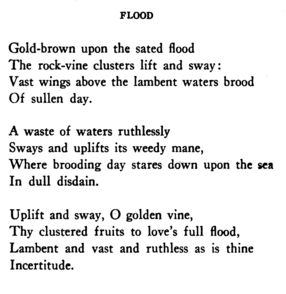‘Cat in the Stacks: Three Poems
 I’m William Repetto, a first-year graduate student at Villanova University. This is the “‘Cat in the Stacks” column. I’m your new ‘cat. I’ll be posting about college life, about learning and growing here at Villanova, and, of course, about the Falvey’s role.
I’m William Repetto, a first-year graduate student at Villanova University. This is the “‘Cat in the Stacks” column. I’m your new ‘cat. I’ll be posting about college life, about learning and growing here at Villanova, and, of course, about the Falvey’s role.
Every few decades, some “brilliant” literary critic declares the “death of poetry.” One need only look around at people quickly browsing social media feeds or getting their latest fix of current events from articles 500 words or fewer to realize that the general public does not care much for engaging literature at the heights of poetry.
The craft, however, continues. Poets of the 20th and 21st centuries have found increasingly interesting and artistic metaphors for thinking through the same facets of human nature as Homer and Shakespeare. For both poets and non-poets, the ‘Cat in the Stacks himself has tracked down three interesting poems for us to work through together.
Flood by James Joyce

(Courtesy of the Poetry Foundation.)
Three images stick out to me in Joyce’s Flood: the flood, the sky, and the debris in-between. The lambent (read: ambient, glowing) flood with its vastness and its swaying seem to symbolize the internal “sea of emotions” that we all feel from day-to-day – perhaps Joyce here is thinking about feelings of “love’s full flood,” but we can think about it as emotion generally.
The sky, then, quickly reminds us of our own interior self-consciousness. Looking down on the flood, the sky sometimes offers “dull disdain.” That leaves a few things in-between, though: the “rock-vine clusters” and “vast wings above.” These seem to me to be elements of the imagination or memory that our emotions and self-consciousness cannot always quickly make sense of.
Regardless of how you want to read these objects between, and, if you see elements of your own emotions of love in the poem, Flood helps the reader think about his/her own interiority, and provides an excellent foundation for the next poem of our post –
Dreams by Langston Hughes
Available through the Academy of American Poets: https://www.poets.org/poetsorg/poem/dreams

Bloom’s collection of critical essays on Hughes
Dreams looks at those interior objects of Flood and asks us to consider the value we place on the ones that relate to ambitions and our vision of the world. Without dreams, “life is a broken-winged bird/that cannot fly,” according to Hughes. Those “vast wings” of Flood have come crashing down without dreams.
Moreover, Hughes states, “Hold fast to dreams/For when dreams go/Life is a barren field/Frozen with snow.” Life cannot produce without dreams, and, for this reason, Hughes cautions us not simply to keep dreams alive but to “hold fast.” Our production, whether it’s artistic, poetic, scientific, or business-related, originates with our dreams.
Hughes poem offers an excellent lens for which we may interrogate our own fidelity to self. So much of modern life, however, depends on what others see from the outside. For thinking through that, let’s turn to the poetry of James Richardson.
How I Became a Saint by James Richardson
Available through The New Yorker: http://www.newyorker.com/magazine/2016/08/08/how-i-became-a-saint-by-james-richardson
Richardson’s first line answers the question posed in the title: “Some sloppy Googling at the Vatican.” This line answers many of the questions we outsiders could have about poetic fame. The truth is that most fame results from misunderstandings.
Richardson then recounts the other James Richardsons who might have been a saint over him, and eventually apologizes: “Sorry, guys: admittedly your Works/were nobler than mine, your Faith purer.” The conclusion, then, is that Richardson became a saint (read: famous) by pure accident.
The poem drastically shifts tone for the final four lines, leaving us wondering about the pronoun “her” and the nature of the fog. Perhaps he means to say that we don’t know where we’re going, but that equally implies that we don’t know where we’ve been.
Conclusion
These poems show, despite the belief that poetry has died in recent decades, that poetry has remained strong and as creative as ever in the last one hundred years. Villanova students have the opportunity to explore these poets more thoroughly in the coming weeks.
On Tuesday, Jan. 31, Richardson himself visited the Connelly Center. This evening, Thursday, Feb. 1, a commemoration of Langston Hughes’ life and work will take place at Speakers’ Corner from 4:30 pm – 6:30 pm in the Falvey, and tomorrow, Thursday, Feb. 2, from 5:30 pm to 7:30 pm, the Irish Studies Program will hold a James Joyce Reception in the President’s Room at the Connelly Center.
Remember, poetry is not dead, Wildcats, and this is only a sampling of the wonders that poetry holds.
 Article by William Repetto, a graduate assistant on the Communications and Marketing Team at the Falvey Memorial Library. He is currently pursuing an MA in English at Villanova University.
Article by William Repetto, a graduate assistant on the Communications and Marketing Team at the Falvey Memorial Library. He is currently pursuing an MA in English at Villanova University.
0 Comments »
No comments yet.
RSS feed for comments on this post. TrackBack URI
